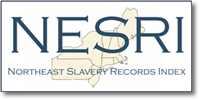The Northeast Slavery Records Index (NESRI) at https://nesri.commons.gc.cuny.edu/ or http://nesri.us provides free access through its website to 94,000 records of slavery in 9 northeastern states from Pennsylvania to Maine, including 45,000 records from New York State, viewable individually or in locality reports. NESRI locates and shares information about enslavement and life events of enslaved people in the Northeast, supporting both academic and community histories of enslavement.
NESRI exists now, a project of John Jay College of Criminal Justice and CUNY. No other source provides the quantity and granularity of data, accessible in free online reports focusing on counties, cities and towns.
A deep understanding of slavery’s many aspects is foundational to designing and implementing reparative programs. NESRI’s mission aligns perfectly with the Commission’s duty to document the capture, procurement, transport, sale, and treatment of enslaved Africa-descended people across New York, and to communicate this individualized information to inform community-level understanding and reparative projects in counties, cities and towns.
NESRI’s data is available now to assist the Commission’s work, and together we could make it even more useful. For NY State there are
- 8,835 records naming individuals who were enslaved;
- 43,111 records naming enslavers, including 209 elected government officials;
- 1,042 records of advertisements for fugitives;
- 559 records of sales; and
- 3,660 records of New York slave ships.
Locally, for example, there are 4,896 records from Ulster County, and 903 records about Hempstead.
Try it. Go online to https://nesri.commons.gc.cuny.edu/dashboard/ and select NY State to see an instant report of the entire collection for NY State. Then specify any town or city and see their slavery records.
NESRI faculty and students are ready to work with the Commission to work toward these goals:
- Expand and enhance NESRI’s records of enslavement of Black and Indigenous people across New York State. We know we can find additional records to continue to build the most complete collection extant.
- Enhance the ability of individuals and communities to access and understand information about enslavement.
- Expand NESRI’s documentation of family relationships among the enslaved people to support genealogical research by descendants.
- Share names of the enslaved people with the 10MillionNames project, further enhancing the ability of descendants to discover their family histories.
- Develop an Enslavement Intensity Measure that will score the intensity of enslavement taking place in each locality based on measures like the percent of people enslaved, and the numbers of political and religious leaders who were enslavers This index could assist the Commission in designing slavery reparation initiatives that focus on places where slavery was most intensive.
- Expand NESRI’s coding of enslavement by colonial era university alumni, donors and staff.
- Design ways for K-12 teachers and college faculty to use NESRI in the classroom.
- Initiate continuing State support for NESRI within CUNY as a unique free resource for individuals and communities studying slavery and designing reparation programs.



